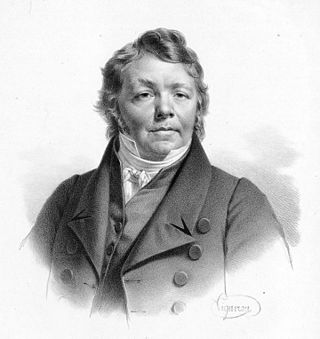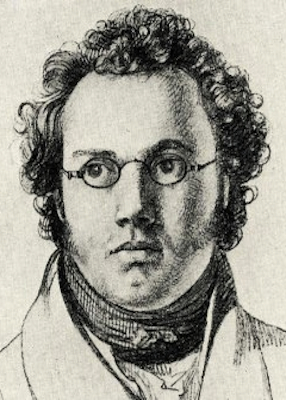Related Research Articles

Johann Nepomuk Hummel was an Austrian composer and virtuoso pianist. His music reflects the transition from the Classical to the Romantic musical era. He was a pupil of Mozart, Salieri and Haydn. Hummel significantly influenced later piano music of the 19th century, particularly in the works of Chopin, Liszt and Mendelssohn.

The Trout Quintet (Forellenquintett) is the popular name for the Piano Quintet in A major, D. 667, by Franz Schubert. The piano quintet was composed in 1819, when he was 22 years old; it was not published, however, until 1829, a year after his death.

The Piano Concerto No. 20 in D minor, K. 466, was composed by Wolfgang Amadeus Mozart in 1785. The first performance took place at the Mehlgrube Casino in Vienna on 11 February 1785, with the composer as the soloist.
Cyclic form is a technique of musical construction, involving multiple sections or movements, in which a theme, melody, or thematic material occurs in more than one movement as a unifying device. Sometimes a theme may occur at the beginning and end ; other times a theme occurs in a different guise in every part.

Franz Xaver Wolfgang Mozart, also known as Wolfgang Amadeus Mozart, Jr., was the youngest child of six born to Wolfgang Amadeus Mozart and his wife Constanze and the younger of his parents' two surviving children. He was a composer, pianist, conductor, and teacher of the late classical period whose musical style was of an early Romanticism, heavily influenced by his father's mature style. He knew Franz Schubert and Robert Schumann, both of whom held him in high esteem.
E major is a major scale based on E, consisting of the pitches E, F♯, G♯, A, B, C♯, and D♯. Its key signature has four sharps. Its relative minor is C-sharp minor and its parallel minor is E minor. Its enharmonic equivalent, F-flat major, has six flats and the double-flat B, which makes that key less convenient to use.
A-flat major is a major scale based on A♭, with the pitches A♭, B♭, C, D♭, E♭, F, and G. Its key signature has four flats.
A minor is a minor scale based on A, B, C, D, E, F, and G. Its key signature has no flats and no sharps. Its relative major is C major and its parallel major is A major.
B minor is a minor scale based on B, consisting of the pitches B, C♯, D, E, F♯, G, and A. Its key signature has two sharps. Its relative major is D major and its parallel major is B major.
F-sharp minor is a minor scale based on F♯, consisting of the pitches F♯, G♯, A, B, C♯, D, and E. Its key signature has three sharps. Its relative major is A major and its parallel major is F-sharp major.
Franz Liszt wrote drafts for his Concerto for Piano and Orchestra No. 2 in A major, S.125, during his virtuoso period, in 1839 to 1840. He then put away the manuscript for a decade. When he returned to the concerto, he revised and scrutinized it repeatedly. The fourth and final period of revision ended in 1861. Liszt dedicated the work to his student Hans von Bronsart, who gave the first performance, with Liszt conducting, in Weimar on January 7, 1857.
The Fantasie in C major, Op. 15, popularly known as the Wanderer Fantasy, is a four-movement fantasy for solo piano composed by Franz Schubert in 1822. It is widely considered Schubert's most technically demanding composition for the piano. Schubert himself said "the devil may play it," in reference to his own inability to do so properly.
An octave glissando is a glissando played on the piano by maintaining a constant distance of an octave between the thumb and finger used to execute it, and shifting the whole hand in the direction of the glissando.
Johann Nepomuk Hummel's Piano Concerto No. 2 in A minor, Op. 85 was written in 1816 and published in Vienna in 1821.
Felix Mendelssohn's Sextet in D major, Op. 110, MWV Q 16, for piano, violin, two violas, cello, and double bass was composed in April–May 1824, when Mendelssohn was only 15, the same time he was working on a comic opera Die Hochzeit des Camacho. Its composition took place between the Viola Sonata and the Piano Quartet No. 3. It also preceded the famous Octet, Op. 20 by about a year. 1824 is also the probable year of the composition of the Clarinet Sonata. Like the latter, the Sextet was not published during the composer's lifetime. Its first edition was issued in 1868 as a part of a complete collection of Mendelssohn's works, hence the misleadingly high opus number.

Christian Ludwig Schuncke was a German pianist and composer, and close friend of Robert Schumann. His early promise was eclipsed by his death from tuberculosis at the age of 23.
Piano Concerto No. 3 in C-sharp minor, Op. 55, by German composer Ferdinand Ries was written around 1813. It was composed in the proto-Romantic style, similar to the concertos of Johann Nepomuk Hummel, and anticipates stylistic developments of future Romantic composers.

Johann Nepomuk Hummel's Piano Sonata No. 5 in F-sharp minor, Op. 81 was written and published in 1819. The work is written in a proto-Romantic style that anticipates the later stylistic developments of composers such as Frédéric Chopin, Franz Liszt, Robert Schumann, Charles-Valentin Alkan, Felix Mendelssohn, and Johannes Brahms.
References
- M.F. Humphries, The Piano Concertos of Johann Nepomuk Hummel, PhD Dissertation (Northwestern University, 1957)
- B.H. Kim, Johann Nepomuk Hummel and His Contribution to Piano Music and the Art of Playing the Piano (University of Rochester, 1967)